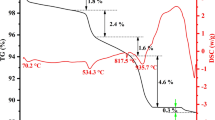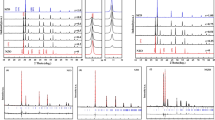Abstract
The aim of this study is to investigate the effect of Zn on the properties of tricalcium silicate (C3S) and its immobilization in C3S hydrates by comparing two different introducing methods. In the first method, Zn was added to C3S during hydration in the form of nitrate salt; whereas in the second process, Zn was introduced into solid solution of C3S during sintering process in the oxide form. The influence of Zn on the formation and polymorph of C3S, hydration properties and its immobilization in the hydrates was analyzed by means of DTA/TG, XRD, FTIR, isothermal heat calorimetry, ICP-AES, etc. In these experiments, when Zn was added as nitrate salt (0.1–3.0 wt%), Zn exhibited a retarding effect on the hydration of C3S. When doped during sintering process, Zn improved the formation of C3S and caused a C3S polymorph from T1 to R with the addition of Zn increased from 0.1 to 3.0 wt%. Besides, a Zn addition of 1.0 wt% prolonged the induction period but increased the hydration rate. Leaching tests implied that both two introducing methods exhibit good performance in Zn immobilization. Concerning the obvious delay in C3S hydration when Zn is added as soluble nitrate salt, the immobilization of Zn during sintering process is a good alternative to treat Zn containing waste.







Similar content being viewed by others
References
Cocke DL, Mollah MY, Parga JR, Hess TR, Ortego JD (1992) An XPS and SEM/EDS characterization of leaching effects on lead-doped and zinc doped Portland cement. J Hazard Mater 30:83–95
Lo IMC, Tang CI, Li XD, Poon CS (2000) Leaching and microstructural analysis of cement-based solidified wastes. Environ Sci Technol 34:5038–5042
Batchelor B (2006) Overview of waste stabilization with cement. Waste Manage 26:689–698
Chen QY, Hills CD, Tyrer M, Slipper I, Shen HG, Brough A (2007) Characterization of products of tricalcium silicate hydration in the presence of heavy metals. J Hazard Mater 147:817–825
Gineys N, Aouad G, Damidot D (2010) Managing trace elements in Portland cement-Part I: interactions between cement paste and heavy metals. Cement Concrete Compos 32:563–570
Gineys N, Aouad G, Damidot D (2011) Managing trace elements in Portland cement-Part II: comparison of two methods to incorporate Zn in a cement. Cement Concrete Compos 33:629–636
Zhang J, Liu J, Li C, Nie Y, Jin Y (2008) Comparison of the fixation of heavy metals in raw material, clinker and mortar using a BCR sequential extraction procedure and NEN7341 test. Cement Concrete Res 38:675–680
Kakali G (1995) Investigation of the effect of Zn oxide on the formation of Portland cement clinker. Cement Concrete Res 25:79–85
Saikia N, Kato S, Kojima T (2007) Production of cement clinkers from municipal solid waste incineration (MSWI) fly ash. Waste Manage 27:1178–1189
Pan JR, Huang C, Kuo JJ, Lin SH (2008) Recycling MSWI bottom and fly ash as raw materials for Portland cement. Waste Manage 28:1113–1118
Chen HX, Ma X, Dai HJ (2010) Reuse of water purification sludge as raw material in cement production. Cement Concrete Compos 32:436–439
Stephan D, Mallmann R, Knöfel D, Härdtl R (1999) High intakes of Cr, Ni and Zn in clinker part I: influence on burning process and formation phases. Cement Concrete Res 29:1949–1957
Stephan D, Maleki H, Knöfel D, Eber B, Härdtl R (1999) Influence of Cr, Ni and Zn on the properties of pure clinker phases part I: C3S. Cement Concrete Res 29:545–552
Stephan D, Maleki H, Knöfel D, Eber B, Härdtl R (1999) Influence of Cr, Ni and Zn on the properties of pure clinker phases part II: C3A and C4AF. Cement Concrete Res 29:651–657
Chen YL, Shih PH, Chiang LC, Chang YK, Lu HC, Chang JE (2009) The influence of heavy metals on the polymorphs of dicalcium silicate in the belite-rich clinkers produced from electroplating sludge. J Hazard Mater 170:443–448
Akatsu K, Ikawa K, Maeda K (1968) Some effects of zinc oxide in the raw mix on the Portland cement and clinker. CAJ review of the 22nd General Meeting. Cement Assoc Japan 22:40–43
Knöfel D (1978) Modifying some properties of Portland cement clinker and cement by means of ZnO and ZnS. Zement Kalk Gips Int. 33:157–161
Arliguie G, Ollivier JP, Grandet J (1982) Etude de l’effet retardateur du zinc sur l’hydratation de la pate de ciment Portland. Cement Concrete Res 12:79–86
Weeks C, Hand RJ, Sharp JH (2008) Retardation of cement hydration caused by heavy metals present in ISF slag used as aggregate. Cement Concrete Compos 30:970–978
Boikova IA (1986) Chemical composition of raw materials as the main factor responsible for the composition, structure and properties of clinkers phases. 8th International Congress on the Chemistry of Cement, Rio de Janeiro
Stephan D, Mallmann R, Knöfel D, Härdtl R (1999) High intakes of Cr, Ni and Zn in clinker part II: influence on the hydration properties. Cement Concrete Res 29:1959–1967
Regourd M (1979) Polymorphisme du silicate tricalcique. Nouvelles données de la diffraction des rayons X. Comptes rendus de l’Académie des Sciences de Paris 289(B) 17–20
Urabe K, Nakano H, Morita H (2002) Structural modulations in monoclinic tricalcium silicate solid solutions doped with zinc oxide, M(I), M(II), and M(III). J Am Ceram Soc 85(2):423–429
Lin Q, Lan XH, Li YB, Ni YR, Lu CH, Chen YX, Xu ZZ (2011) Preparation and in vitro bioactivity of zinc incorporating tricalcium silicate. Mater Sci Eng 31:629–636
Chinese National Standard (2008) GB176-2008: Method for chemical analysis of cement. Chinese Standards Institute. (in Chinese)
Saikia N, Kato S, Kojima T (2007) Production of cement clinkers from municipal solid waste incineration (MSWI) fly ash. Waste Manage 27:1178–1189
Chinese National Standard (2007) HJ/T299-2007: Solid waste-Extraction procedure for leaching toxicity-Sulphuric acid & nitric acid method. Chinese Standards Institute. (in Chinese)
Odler I, Abdul-Maula S (1983) Polymorphism and hydration of tricalcium silicate doped with ZnO. J Am Ceram Soc 66(1):1–4
Wang S, Li G, Yin C, Lu C (2012) Effect of strontium dioxide on the crystal structure and properties of tricalcium silicate. Adv Cement Res 24(6):359–364
Taylor HFW (1990) Cement Chemistry. Academic Press Inc., New York
Bigaré M, Guinier A, Mazières C, Regourd M, Yannaquis N, Eysel W, Hahn Th, Woermann E (1967) Polymorphism of tricalcium silicate and its solid solutions. J Am Ceram Soc 50(11):609–619
Dunstetter F, de Noirfontaine MN, Courtial M (2006) Polymorphism of tricalcium silicate, the major compound of Portland cement clinker 1. Structural data: review and unified analysis. Cement Concrete Res 36:39–53
Urabe K, Shirakami T, Iwashima M (2000) Superstructure in a triclinic phase of tricalcium silicate. J Am Ceram Soc 83(5):1253–1258
Wang PM, Li HX, Wu JG (2007) Formation of Tricalcium Silicate with different content of copper oxide. J Chin Ceram Soc 35(10):1353–1358
Sinclair W, Groves GW (1984) Transmission electron microscopy and X-Ray diffraction of doped tricalcium silicate. J Am Ceram Soc 67(5):325–330
Omotoso OE, Ivey DG, Mikula R (1995) Characterization of chromium doped tricalcium silicate using SEM/EDS, XRD and FTIR. J Hazard Mater 42:87–102
Handke M, Jurkiewicz ME (1979) IR and Raman spectroscopy studies of tricalcium silicate structure. Ann Chim Fr 4:145–161
Christodoulou I, Buttery LDK, Saravanapavan P, Tai G, Hench LL, Polak JM (2005) Dose- and time-dependent effect of bioactive gel-glass ionic-dissolution products on human fetal osteoblast-specific gene expression. J Biomed Mater Res Part B 74:529–537
US EPA (1994) Toxicity characteristic leaching procedure (TCLP). 40 CFR 261, Appendix II, US Environmental Protection Agency, Washington
Chinese National Standard (2007) GB5085.3-2007: Identification standards for hazardous waste-Identification for extraction toxicity. Chinese Standards Institute. (in Chinese)
Acknowledgments
This work was done in cooperation and with financial support of the National Natural Science Foundation of China (51002110), the Fundamental Research Funds for the Central Universities (2012-IV-025) and State Scholarship Program of China Scholarship Council.
Author information
Authors and Affiliations
Corresponding authors
Rights and permissions
About this article
Cite this article
Lv, Y., Li, X., Ma, B. et al. Managing Zn wastes in C3S: comparison of two incorporation methods. Mater Struct 48, 2659–2669 (2015). https://doi.org/10.1617/s11527-014-0344-1
Received:
Accepted:
Published:
Issue Date:
DOI: https://doi.org/10.1617/s11527-014-0344-1




